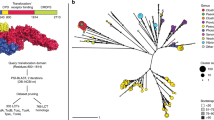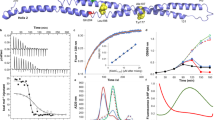Abstract
Colicins are folded protein toxins that face the formidable task of translocating across one or both of the Escherichia coli cell membranes in order to induce cell death. This translocation is achieved by parasitizing host proteins. There has been much recent progress in our understanding of the early stages of colicin entry, including the binding of outer-membrane nutrient transporters and porins and the subsequent recruitment of periplasmic and inner-membrane proteins that, together, trigger translocation. As well as providing insights into how these toxins enter cells, these studies have highlighted some surprising similarities in the modes of action of the systems that colicins subvert.
This is a preview of subscription content, access via your institution
Access options
Subscribe to this journal
Receive 12 print issues and online access
$209.00 per year
only $17.42 per issue
Buy this article
- Purchase on Springer Link
- Instant access to full article PDF
Prices may be subject to local taxes which are calculated during checkout



Similar content being viewed by others
References
Riley, M. A. & Wertz, J. E. Bacteriocins: evolution, ecology and application. Annu. Rev. Microbiol. 56, 117–137 (2002).
Kerr, B., Riley, M. A., Feldman, M. W. & Bohannan, B. J. Local dispersal promotes biodiversity in a real-life game of rock–paper–scissors. Nature 418, 171–174 (2002).
Kirkup, B. C. & Riley, M. A. Antibiotic-mediated antagonism leads to a bacterial game of rock–paper–scissors in vivo. Nature 428, 412 (2004).
Majeed, H., Gillor, O., Kerr, B. & Riley, M. A. Competitive interactions in Escherichia coli populations: the role of bacteriocins. ISME J. 22 Jul 2010 (doi:10.1038/ismej.2010.90).
Gillor, O., Etzion, A. & Riley, M. A. The dual role of bacteriocins as anti- and probiotics. Appl. Microbiol. Biotechnol. 81, 591–606 (2008).
Gordon, D. M. The potential of bacteriocin-producing probiotics and associated caveats. Future Microbiol. 4, 941–943 (2008).
Schamberger, G. P., Phillips, R. L., Jacobs, J. L. & Diez-Gonzalez, F. Reduction of Escherichia coli O157:H7 populations in cattle by addition of colicin E7-producing E. coli to feed. Appl. Environ. Microbiol. 70, 6053–6060 (2004).
Gratia, A. Sur un remarquable exemple d'antagonisme entre deux souches de colibacille. C. R. Soc. Biol. 93, 1040–1041 (1925) (in French).
Cascales, E. et al. Colicin biology. Microbiol. Mol. Biol. Rev. 71, 158–229 (2007).
Wiener, M., Freymann, D., Ghosh, P. & Stroud, R. M. Crystal structure of colicin Ia. Nature 385, 461–464 (1997).
Soelaiman, S., Jakes, K., Wu, N., Li, C. & Shoham, M. Crystal structure of colicin E3: implications for cell entry and ribosome inactivation. Mol. Cell 8, 1053–1062 (2001).
Hilsenbeck, J. L. et al. Crystal structure of the cytotoxic bacterial protein colicin B at 2.5 Å resolution. Mol. Microbiol. 51, 711–720 (2004).
Vetter, I. R. et al. Crystal structure of a colicin N-fragment suggests a model for toxicity. Structure 6, 863–874 (1998).
Zeth, K., Romer, C., Patzer, S. I. & Braun, V. Crystal structure of colicin M, a novel phosphatase specifically imported by Escherichia coli. J. Biol. Chem. 283, 25324–25331 (2008).
Arnold, T., Zeth, K. & Linke, D. Structure and function of colicin S4, a colicin with a duplicated receptor-binding domain. J. Biol. Chem. 284, 6403–6413 (2009).
Anderluh, G., Gokce, I. & Lakey, J. H. A natively unfolded toxin domain uses its receptor as a folding template. J. Biol. Chem. 279, 22002–22009 (2004).
Collins, E. S. et al. Structural dynamics of the membrane translocation domain of colicin E9 and its interaction with TolB. J. Mol. Biol. 318, 787–804 (2002).
Schaller, K. & Nomura, M. Colicin E2 is DNA endonuclease. Proc. Natl Acad. Sci. USA 73, 3989–3993 (1976).
Jakes, K. S. & Zinder, N. D. Highly purified colicin E3 contains immunity protein. Proc. Natl Acad. Sci. USA 71, 3380–3384 (1974).
Olschläger, T., Turba, A. & Braun, V. Binding of the immunity protein inactivates colicin M. Mol. Microbiol. 5, 1105–1111 (1991).
Kleanthous, C. & Walker, D. Immunity proteins: enzyme inhibitors that avoid the active site. Trends Biochem. Sci. 26, 624–631 (2001).
Gillor, O., Vriezen, J. A. & Riley, M. A. The role of SOS boxes in enteric bacteriocin regulation. Microbiology 154, 1783–1792 (2008).
Di Masi, D. R., White, J. C., Schnaitman, C. A. & Bradbeer, C. Transport of vitamin B12 in Escherichia coli: common receptor sites for vitamin B12 and the E colicins on the outer membrane of the cell envelope. J. Bacteriol. 115, 506–513 (1973).
Kurisu, G. et al. The structure of BtuB with bound colicin E3 R-domain implies a translocon. Nature Struct. Biol. 10, 948–954 (2003).
Sharma, O. et al. Structure of the complex of the colicin E2 R-domain and its BtuB receptor. The membrane colicin translocon. J. Biol. Chem. 282, 23163–23170 (2007).
Buchanan, S. K. et al. Structure of colicin I receptor bound to the R-domain of colicin Ia: implications for protein import. EMBO J. 26, 2594–2604 (2007).
Housden, N. G., Loftus, S. R., Moore, G. R., James, R. & Kleanthous, C. Cell entry mechanism of enzymatic bacterial colicins: porin recruitment and the thermodynamics of receptor binding. Proc. Natl Acad. Sci. USA 102, 13849–13854 (2005).
Jakes, K. & Finkelstein, A. The colicin Ia receptor, Cir, is also the translocator for colicin Ia. Mol. Microbiol. 75, 567–578 (2009).
Zakharov, S. D., Sharma, O., Zhalnina, M. V. & Cramer, W. A. Primary events in the colicin translocon: FRET analysis of colicin unfolding initiated by binding to BtuB and OmpF. Biochemistry 47, 12802–12809 (2008).
Zakharov, S. D. et al. Colicin occlusion of OmpF and TolC channels: outer membrane translocons for colicin import. Biophys. J. 87, 3901–3911 (2004).
Yamashita, E., Zhalnina, M. V., Zakharov, S. D., Sharma, O. & Cramer, W. A. Crystal structures of the OmpF porin: function in a colicin translocon. EMBO J. 27, 2171–2180 (2008).
Baboolal, T. G. et al. Colicin N binds to the periphery of its receptor and translocator, outer membrane protein F. Structure 16, 371–379 (2008).
Anderluh, G. et al. Concerted folding and binding of a flexible colicin domain to its periplasmic receptor TolA. J. Biol. Chem. 278, 21860–21868 (2003).
Bonsor, D. A. et al. Allosteric β-propeller signalling in TolB and its manipulation by translocating colicins. EMBO J. 28, 2846–2857 (2009).
Zhang, Y. et al. The crystal structure of the TolB box of Colicin A in complex with TolB reveals important differences in the recruitment of the common TolB translocation portal used by group A colicins. Mol. Microbiol. 75, 623–636 (2009).
Cadieux, N., Phan, P. G., Cafiso, D. S. & Kadner, R. J. Differential substrate-induced signaling through the TonB-dependent transporter BtuB. Proc. Natl Acad. Sci. USA 100, 10688–10693 (2003).
Wiener, M. C. TonB-dependent outer membrane transport: going for Baroque? Curr. Opin. Struct. Biol. 15, 394–400 (2005).
Kleanthous, C. Translocator hunt comes full Cir-Col. Mol. Microbiol. 75, 529–533 (2009).
Pilsl, H. & Braun, V. The Ton system can functionally replace the TolB protein in the uptake of mutated colicin U. FEMS Microbiol. Lett. 164, 363–367 (1998).
de Zamaroczy, M., Mora, L., Lecuyer, A., Geli, V. & Buckingham, R. H. Cleavage of colicin D is necessary for cell killing and requires the inner membrane peptidase LepB. Mol. Cell 8, 159–168 (2001).
Shi, Z., Chak, K. F. & Yuan, H. S. Identification of an essential cleavage site in ColE7 required for import and killing of cells. J. Biol. Chem. 280, 24663–24668 (2005).
Walker, D., Mosbahi, K., Vankemmelbeke, M., James, R. & Kleanthous, C. The role of electrostatics in colicin nuclease domain translocation into bacterial cells. J. Biol. Chem. 282, 31389–31397 (2007).
Mosbahi, K. et al. The cytotoxic domain of colicin E9 is a channel-forming endonuclease. Nature Struct. Biol. 9, 476–484 (2002).
Mosbahi, K., Walker, D., James, R., Moore, G. R. & Kleanthous, C. Global structural rearrangement of the cell penetrating ribonuclease colicin E3 on interaction with phospholipid membranes. Protein Sci. 15, 620–627 (2006).
Benedetti, H., Lloubes, R., Lazdunski, C. & Letellier, L. Colicin A unfolds during its translocation in Escherichia coli cells and spans the whole cell envelope when its pore has formed. EMBO J. 11, 441–447 (1992).
Duche, D. Colicin E2 is still in contact with its receptor and import machinery when its nuclease domain enters the cytoplasm. J. Bacteriol. 189, 4217–4222 (2007).
Cascales, E., Gavioli, M., Sturgis, J. N. & Lloubes, R. Proton motive force drives the interaction of the inner membrane TolA and outer membrane Pal proteins in Escherichia coli. Mol. Microbiol. 38, 904–915 (2000).
Gerding, M. A., Ogata, Y., Pecora, N. D., Niki, H. & de Boer, P. A. The trans-envelope Tol–Pal complex is part of the cell division machinery and required for proper outer-membrane invagination during cell constriction in E. coli. Mol. Microbiol. 63, 1008–1025 (2007).
Bonsor, D. A., Grishkovskaya, I., Dodson, E. J. & Kleanthous, C. Molecular mimicry enables competitive recruitment by a natively disordered protein. J. Am. Chem. Soc. 15, 4800–4807 (2007).
Loftus, S. R. et al. Competitive recruitment of the periplasmic translocation portal TolB by a natively disordered domain of colicin E9. Proc. Natl Acad. Sci. USA 103, 12353–12358 (2006).
Vankemmelbeke, M. N. et al. Energy dependent immunity protein release during tol-dependent nuclease colicin translocation. J. Biol. Chem. 284, 18932–18941 (2009).
Witty, M. et al. Structure of the periplasmic domain of Pseudomonas aeruginosa TolA: evidence for an evolutionary relationship with the TonB transporter protein. EMBO J. 21, 4207–4218 (2002).
Noinaj, N., Guillier, M., Barnard, T. J. & Buchanan, S. K. TonB-dependent transporters: regulation, structure and function. Annu. Rev. Microbiol. 64, 43–60 (2010).
Hecht, O., Ridley, H., Lakey, J. H. & Moore, G. R. A common interaction for the entry of colicin N and filamentous phage into Escherichia coli. J. Mol. Biol. 388, 880–893 (2009).
Jakes, K. S., Davis, N. G. & Zinder, N. D. A hybrid toxin from bacteriophage f1 attachment protein and colicin E3 has altered cell receptor specificity. J. Bacteriol. 170, 4231–4238 (1988).
Braun, V. & Herrmann, C. Evolutionary relationship of uptake systems for biopolymers in Escherichia coli: cross-complementation between the TonB-ExbB-ExbD and the TolA-TolA-TolR proteins. Mol. Microbiol. 8, 261–268 (1993).
Acknowledgements
Many thanks to N. Housden for help with figures 2 and 3, and to G. Thomas for helpful comments on the manuscript. My sincere thanks to all my colIaborators and to members of my laboratory, past and present, for their contributions to the colicin project. In particular, I thank R. James and G. Moore for introducing me to the world of colicin biology. I gratefully acknowledge funding for our work on colicins and Tol proteins from the Biotechnology and Biological Sciences Research Council of the UK and The Wellcome Trust.
Author information
Authors and Affiliations
Ethics declarations
Competing interests
The author declares no competing financial interests.
Related links
Rights and permissions
About this article
Cite this article
Kleanthous, C. Swimming against the tide: progress and challenges in our understanding of colicin translocation. Nat Rev Microbiol 8, 843–848 (2010). https://doi.org/10.1038/nrmicro2454
Published:
Issue Date:
DOI: https://doi.org/10.1038/nrmicro2454
This article is cited by
-
Antimicrobial Peptides (Bacteriocins) Produced by Lactococcus lactis and Pediococcus pentosaceus Strains with Activity Against Clinical and Food-Borne Pathogens
Probiotics and Antimicrobial Proteins (2023)
-
Genomic and proteomic characterization of two strains of Shigella flexneri 2 isolated from infants’ stool samples in Argentina
BMC Genomics (2022)
-
Structural and functional insights into colicin: a new paradigm in drug discovery
Archives of Microbiology (2022)
-
Toxin import through the antibiotic efflux channel TolC
Nature Communications (2021)
-
Broad and Efficient Control of Klebsiella Pathogens by Peptidoglycan-Degrading and Pore-Forming Bacteriocins Klebicins
Scientific Reports (2019)



